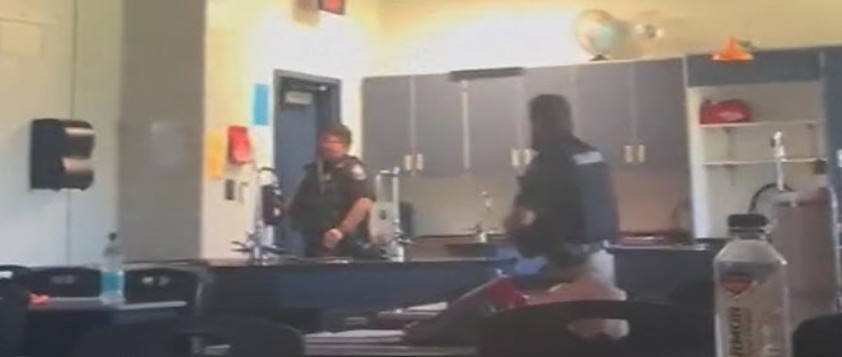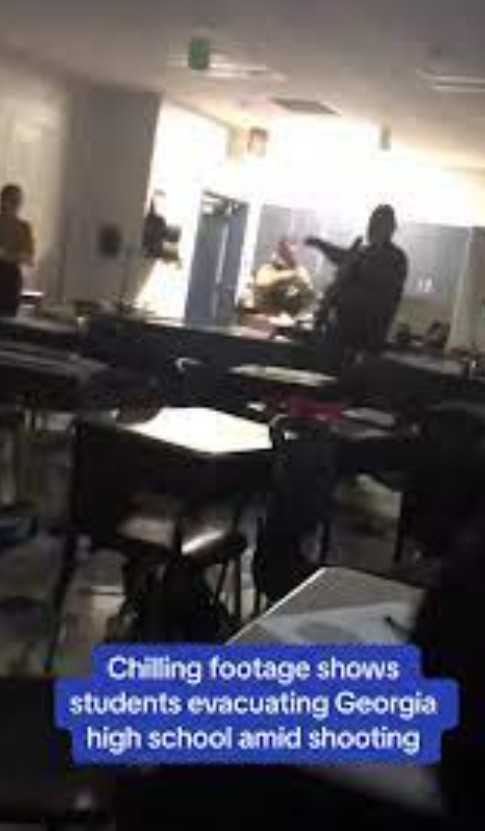Georgia School Shooting Video Prompts Local
On a tragic Wednesday in Winder, Georgia, a 14-year-old student opened fire at Apalachee High School, a campus usually known for its lively learning atmosphere. Armed with an assault-style rifle, the attacker killed four people two fellow students and two teachers before being taken into custody. The shooting shook the community and cast a shadow over a school long regarded as a safe and vibrant place for education.
As gunfire rang through the halls, students and staff reacted quickly. Many locked classroom doors and stacked desks and chairs to block entry. In one health class, a “hard lockdown” alert flashed across a screen, prompting students to build a barricade while trying to remain calm. Their swift, coordinated actions reflected both the fear and resilience that have become an unfortunate reality for young people in American schools.

Elsewhere, teachers turned into first responders, using clothing to slow bleeding and guide students to safety. School resource officers and local police arrived rapidly, confronting the shooter, who surrendered without further violence. Their quick intervention likely prevented even greater loss.
This painful day at Apalachee High underscores the growing number of school shootings affecting communities across the United States. It highlights urgent questions about campus safety, access to firearms, and the emotional toll such events impose on students, educators, and families nationwide.
Contents
Incident Overview and Video Footage
A quiet midday at Apalachee High School in Winder, Georgia, was tragically disrupted when a 14-year-old student opened fire shortly before noon, turning a normal school day into one of grief and shock. The gunfire ended the lives of four people inside the school, shaking a community that had long viewed the campus as a safe place for learning and connection.
Georgia School Shooting Video and the Story Behind the Winder Tragedy
georgia-school-shooting-video.mp4
The victims were identified as students Mason Schermerhorn and Christian Angulo, both 14, and teachers Richard Aspinwall and Christina Irimie. All four were respected members of the school, remembered by classmates and colleagues for their warmth and dedication. Their sudden loss has left a deep impact on students, staff, and families throughout Winder.
The suspect, also a student at the school, was taken into custody only minutes after the shooting began. School resource officers and local law enforcement acted quickly, leading to his immediate surrender and helping secure the campus to protect others from harm.
Eyewitness Accounts
Amid the chaos, first-hand stories from those inside Apalachee High School reveal a powerful mix of fear, courage, and solidarity.
Junior Layla Ferrell described how an ordinary health class changed instantly once a “hard lockdown” alert appeared on the screen. Students pushed desks and chairs against the door, turning their classroom into a place of protection as they tried to stay calm and safe together.
In a nearby geometry room, Kaylee Abner, a sophomore, remembered the moment panic swept through her classmates when they heard gunfire. Guided by their teacher, they ducked behind desks and used them as barriers. Kaylee said holding a friend’s hand and quietly praying helped her feel less alone in that frightening moment.
Parents outside the school also faced agonizing uncertainty. Erin Clark, whose son Ethan was inside during the attack, recalled racing from her job after receiving his text about an active shooter. The messages they exchanged during her drive filled with love and fear showed how deeply families are affected in such crises. Seeing Ethan safe later, sitting with other students on the bleachers, brought overwhelming relief after an anxious wait.
These accounts, from students protecting one another to a mother’s determined rush to reach her child, illustrate both the trauma and bravery that emerge in moments of danger. As the community works to heal, their stories stand as reminders of resilience and support in the face of tragedy.
Law Enforcement and Emergency Response
The swift actions of law enforcement were crucial in bringing the situation at Apalachee High School under control and limiting further harm. Within minutes of the first reports of gunfire, two school resource officers located the suspect, who surrendered almost immediately. Their rapid intervention underscored the value of having trained personnel on campus, prepared to respond to emergencies in real time.

At the same time, medical teams and first responders worked quickly to assist the wounded. Teachers and staff improvised first aid while waiting for paramedics, using available supplies to stabilize injuries. Victims were transported to nearby hospitals without delay. Thanks to this coordinated response between school officials, law enforcement, and medical providers, all those injured were able to receive timely care, and doctors expressed optimism about their recovery.
Background and Security Gaps
Investigations into the events preceding the tragedy have revealed warning signs and weaknesses in existing safety measures. Months before the shooting, the FBI received anonymous tips suggesting that the student who later carried out the attack had made threats online. Federal agents reviewed the information and passed the matter to the Jackson County Sheriff’s Office for follow-up.
Local deputies interviewed the then-13-year-old and his father, who acknowledged having hunting rifles at home but assured authorities the child did not have unsupervised access. Based on the evidence at the time, there was no legal basis for stronger action, though schools were notified to monitor the student’s behavior. In hindsight, these steps were not enough to prevent the attack.
How the student acquired and brought an assault-style rifle onto campus remains under investigation. The case raises concerns about firearm storage in households with children and highlights the need for consistent safety practices to prevent unauthorized access.
The fact that the weapon was brought into a school undetected also points to shortcomings in campus security. Whether due to gaps in screening procedures, limited surveillance, or other physical safeguards, the systems in place did not adequately prevent the entry of a firearm.
These findings underscore the importance of strengthening threat assessment, improving communication between federal and local agencies, and reviewing school safety protocols. The tragedy at Apalachee High serves as a somber reminder of the work still needed to protect students and staff from acts of violence.
Community Reaction
In the wake of the tragedy at Apalachee High School, the people of Winder, Georgia and many across the country responded with sorrow, solidarity, and renewed calls for change.
Local Sheriff Jud Smith, visibly moved, spoke of the deep personal impact the event had on the county. He pledged that “hate will not prevail,” emphasizing a collective commitment to compassion and unity in the face of violence. His words captured the shared pain and resilience felt by families, students, and staff.
National leaders also expressed concern and outrage. During a campaign stop, Vice President Kamala Harris described the ongoing fear parents experience about their children’s safety in schools as “outrageous.” Former President Donald Trump lamented the loss of young lives and described the shooter as “sick and deranged.” Their remarks reflected the widespread alarm over repeated school shootings and the broader debate about preventing gun violence in education settings.
That evening, hundreds gathered at Jug Tavern Park for a candlelight vigil honoring the victims. Students, staff, and residents including participants from both Apalachee High and nearby Winder-Barrow High joined together in mourning. Prayers, reflections, and moments of silence from different faith traditions created a space for healing and support.
The tragedy has also renewed scrutiny of school safety measures. Despite regular active-shooter drills and upgraded security systems, campuses remain vulnerable to acts of violence. The shooting at Apalachee adds to a growing list of incidents that have intensified discussions about firearm regulation, mental health services, and the role of communities in keeping schools safe.
Preventing future violence will require coordinated efforts from policymakers, educators, and residents alike. Proposals range from improving secure firearm storage and expanding mental health resources for students to strengthening campus security procedures and investing in early intervention programs.
Amid grief, the response from Winder shows a determination to stand together and build safer schools. Through empathy, dialogue, and practical solutions, communities can honor the victims’ memory and work toward an environment where every child can learn without fear.
Breaking News -Mar Urista Video Viral and the Impact on Privacy Concerns
Edwin Cruz Gomez Full Video and Jhoanny Alvarez Death
Yailin and Tekashi Video Leak Leaves Fans in Shock
Whitney Wren and Christen Whitman Video Surfaces
Heccymar TikTok Video Viral on Privacy Violations
McKinley Richardson Video Leak Sparks Outrage and Debate
Luz Arias Video Sparks Outrage and Viral Discussions
